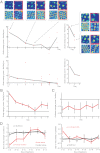Grid cell firing patterns signal environmental novelty by expansion
- PMID: 23045662
- PMCID: PMC3491492
- DOI: 10.1073/pnas.1209918109
Grid cell firing patterns signal environmental novelty by expansion
Abstract
The hippocampal formation plays key roles in representing an animal's location and in detecting environmental novelty to create or update those representations. However, the mechanisms behind this latter function are unclear. Here, we show that environmental novelty causes the spatial firing patterns of grid cells to expand in scale and reduce in regularity, reverting to their familiar scale as the environment becomes familiar. Simultaneously recorded place cell firing fields remapped and showed a smaller, temporary expansion. Grid expansion provides a potential mechanism for novelty signaling and may enhance the formation of new hippocampal representations, whereas the subsequent slow reduction in scale provides a potential familiarity signal.
Conflict of interest statement
The authors declare no conflict of interest.
Figures



References
-
- Hafting T, Fyhn M, Molden S, Moser MB, Moser EI. Microstructure of a spatial map in the entorhinal cortex. Nature. 2005;436:801–806. - PubMed
-
- Barry C, Hayman R, Burgess N, Jeffery KJ. Experience-dependent rescaling of entorhinal grids. Nat Neurosci. 2007;10:682–684. - PubMed
-
- Fyhn M, Hafting T, Treves A, Moser MB, Moser EI. Hippocampal remapping and grid realignment in entorhinal cortex. Nature. 2007;446:190–194. - PubMed
-
- Sargolini F, et al. Conjunctive representation of position, direction, and velocity in entorhinal cortex. Science. 2006;312:758–762. - PubMed
Publication types
MeSH terms
Grants and funding
LinkOut - more resources
Full Text Sources

